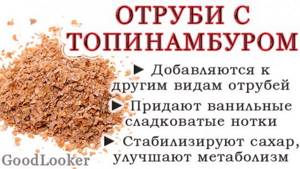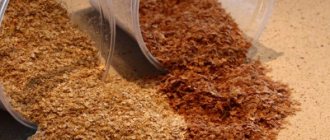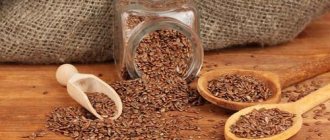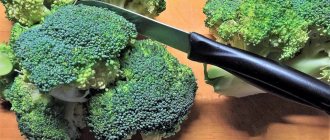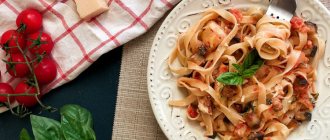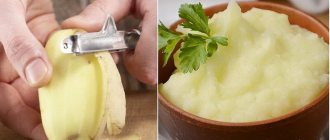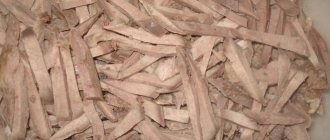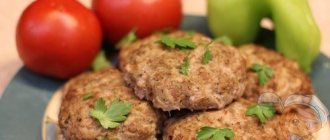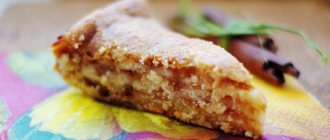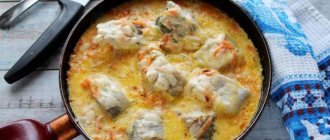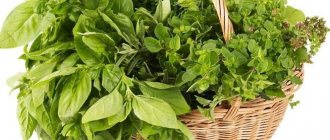Calculation of calories, percentage of proteins, fats, carbohydrates is the basis of proper nutrition. However, an equally important component of the diet, which is responsible for the functioning of the gastrointestinal tract and the health of the body as a whole, is often forgotten. We are talking about dietary fiber or, in other words, fiber.
If you find it difficult to get fiber from vegetables and herbs, be sure to include bran in your diet, the benefits of which have been scientifically proven.
The benefits and harms of bran. Subtleties of using a sensational product
Bran is a by-product of grain processing. It is the outer shell of a cereal, valued for its high content of insoluble fiber, or cellulose. Previously, the husk was used exclusively for livestock feed, until scientists discovered its enormous benefits for the human body. Today, bran is a popular product in dietetics. It should be remembered that only correct use can bring benefits, eliminating side effects.
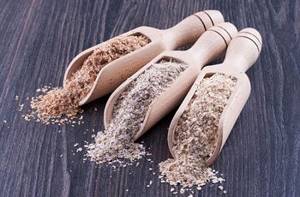
How to take bran for weight loss
Experienced nutritionists often recommend that people who want to lose weight introduce wheat husks into their diet. It can create a long-lasting satiety effect by swelling in the stomach, and thereby provide benefits by preventing overeating.
Fiber, in turn, normalizes metabolic processes, which is very important when losing weight.
With a large selection of bran on store shelves, many are lost, not knowing which one to choose. Which ones will benefit a particular person must be determined individually, taking into account the recommendations of doctors.
Nutritionists identify two types of bran that have the most beneficial properties for losing weight:
- Wheat. This product is able to stimulate the proper functioning of the gastrointestinal tract. They are one of the cheapest, which is also a big plus.
- Oatmeal. This species is very useful for diabetes and for its prevention. Oat bran prevents overeating, maintaining a feeling of a full stomach for a long time.
What types of bran are there?
Any grain has an outer shell, which is removed when the grain is cleaned and polished. That is why bran is different, different in appearance, smell, taste. Main types:
Sometimes you can find flax, corn, barley, buckwheat and other types of products on sale. Undoubtedly, they all contain a large amount of fiber, they are all useful, but they work differently and have their own composition and taste. Bran also differs in the degree of purification. The thinner and better processed the grain shell, the lower the carbohydrate content and calorie content, and the more insoluble fiber.
What's inside: chemical composition
You cannot talk about the benefits or harms of a product without familiarizing yourself with the composition. Depending on the original raw material, the caloric content, vitamin and mineral content are different. Rice bran contains a large amount of phosphorus, iron, and thiamine. Wheat product is rich in potassium, magnesium, chromium, zinc. Oat bran is considered the leader in fiber content. They are an essential component of the world-famous diet of Dr. Dukan.
Calorie table per 100 g of product
| Rice | Oatmeal | Wheat | Rye | |
| Calories (kcal) | 316 | 246 | 216 | 221 |
| Proteins (g) | 13,35 | 17,3 | 15,55 | 11,2 |
| Fat (g) | 20,85 | 7.03 | 4,25 | 3,2 |
| Carbohydrates (g) | 28,9 | 66,2 | 64,51 | 32 |
Table of vitamins and minerals in different types of bran per 100 g of product
| Vitamins | % of daily value | ||
| Rice | Oatmeal | Wheat | |
| Kholin | 6 | 6 | — |
| B1 | 184 | 78 | 35 |
| B9 | 16 | 13 | — |
| B2 | 16 | 12 | 32 |
| B6 | 204 | 8 | 65 |
| B5 | 148 | 30 | 44 |
| Vitamin E | 33 | 7 | 10 |
| Vitamin PP | 170 | 5 | 53 |
| Vitamin A | — | — | 1 |
| Vitamin K | 2 | 3 | 2 |
| Minerals | |||
| Selenium | 28 | 82 | 141 |
| Phosphorus | 210 | 92 | 119 |
| Sodium | — | — | 1 |
| Iron | 103 | 30 | 59 |
| Magnesium | 195 | 59 | 153 |
| Calcium | 6 | 6 | 7 |
| Zinc | 50 | 26 | 61 |
| Potassium | 59 | 23 | 50 |
In fact, the composition of nutrients, vitamins, carbohydrates and minerals in bran is not as important as the presence of fiber. It is insoluble fibers that pass through the digestive tract in transit, absorb water, toxins and other substances from the intestines, thereby cleansing it, enhancing motility, and relieving constipation.
Video: Doctor Kovalkov about carbohydrates in bran
What wheat goes to waste?
When processing wheat grain, the flower shell, rudiment, and aleurone layer of endosperm remain in the bran. 90% of the biologically active elements of the plant are concentrated here.
Calorie content
100 g of product – 215 kcal.
The nutritional value
:
- proteins – 15.8 g (20%*);
- fats – 4.2 g (5%);
- carbohydrates – 65 g (18%);
- dietary fiber – 43 g (150%);
- water – 10 g.
* Percentage of daily requirement satisfaction for a diet of 2500 kcal.
Vitamins
:
- B1 (thiamine) – 0.6 mg;
- B2 (riboflavin) – 0.7 mg;
- B3 (niacin) – 14 mg;
- B5 (pantothenic) – 2.4 mg;
- B6 (pyridoxine) – 1.5 mg;
- E (tocopherol) – 1.7 mg;
- K – 2 mcg.
Mineral composition
:
- potassium – 1180 mg;
- phosphorus – 1020 mg;
- magnesium – 610 mg;
- calcium – 75 mg;
- iron – 10 mg;
- zinc – 8 mg.
Useful properties of bran
Most people have one goal when consuming grain shells: losing weight. Not every person thinks about improving the health of the body. In fact, one cannot exist without the other. If you use bran correctly, the benefits and harms of which have already been sufficiently studied, then you can cope with many intestinal problems, normalize its functioning, and cleanse it of fecal deposits. And all this without the use of aggressive means, questionable and dangerous methods. Colitis, diverticulosis, hemorrhoids are often associated with insufficient dietary fiber.
The main beneficial properties of bran:
- improve digestion;
- cleanse the body of toxins, waste, heavy metals;
- promotes the removal of cholesterol;
- lower blood sugar levels;
- Promotes quick satiety and satisfies hunger well.
In a cleansed body, the processes of breakdown and absorption of substances from food occur much faster. Due to the emptying of the intestines and the removal of decomposition products from the body, the condition of the skin improves, acne on the face and body disappears.
Medicinal properties of bran
Many people introduce bran into their diet even in the absence of any indications. However, there is a list of diseases and deviations from the normal functioning of the body when this healthy food is strongly recommended for use.
- Diabetes. Fiber, which is found in large quantities in seedlings, has the ability to normalize blood glucose levels.
- High cholesterol levels. Thanks again to the beneficial fiber.
- Hypertension.
- Constipation, including chronic.
- Obesity. This problem can cause irreparable harm to human health.
- Tendency to allergic reactions.
- Skin diseases, including acne. Such problems, as we know, should be treated from the inside. Acne bran can significantly improve skin condition.
- Weak immunity.
Using bran for weight loss
All kinds of diets for weight loss, unbalanced, monotonous, unhealthy diets often lead to constipation. This is reflected not only in the figure, but also in the condition and color of the skin. It is bran that will help cope with stagnation in the intestines and easily and safely get rid of several kilograms. Moreover, bran helps reduce the load on the excretory organs if there is a sharp loss of body weight. This is especially true for people who follow protein diets, which are accompanied by a sharp release of acetone into the body.
Bran is taken in its pure form, washed down with water, and added to porridge and baked goods. But one of the best ways is to combine the daily portion with fermented milk drinks. This can be natural yogurt, kefir, fermented baked milk, yogurt. Fruits and berries are added for taste. If the specific roughness of the shells bothers you, you can prepare the mixture in the evening so that the fibers swell and become softer.
Very important! When taking bran, increase the amount of fluid to 2.5 liters per day. It will additionally promote weight loss and also prevent dehydration.
The optimal daily dose of bran for oral administration is from 30 to 60 grams. Excessive consumption of the product can be harmful to the body, causing increased gas formation and bloating.
Video: Elena Malysheva: bran prevents you from getting fat and aging!
What are the benefits of bran?
The product is therapeutic and prophylactic. The main advantage is 43! grams of dietary fiber and a full set of B vitamins. Let's consider the effect of wheat meal on individual body systems.
Gastrointestinal tract
- Dietary fiber has a porous structure. Due to this, a lot of liquid is retained. Penetrating into the intestines, it liquefies and gently removes feces. Therefore, it is recommended to eat wheat bran for constipation.
- Fiber absorbs waste and toxins accumulated in the intestines. And pushes out metabolic by-products naturally.
- With constipation, harmful substances are retained in the gastrointestinal tract, absorbed into the blood and irritate the mucous membrane. Hemorrhoids develop. Regular use of wheat “waste” is an effective prevention.
- Since poisons are eliminated in time, the intestinal mucosa is less damaged. The likelihood of developing colon cancer is minimal.
- Fiber is a food source for beneficial bacteria. Therefore, bran is considered a therapeutic and prophylactic product for dysbacteriosis.
- Vitamin B3 activates the secretion of gastric juice, improves the functionality of the pancreas and liver.
- Dietary fiber normalizes bile secretion, absorbs “bad” bile acids and bad cholesterol.
Obesity and hormonal levels
- The fibrous, porous structure of the product absorbs liquid in the stomach and expands. The person feels full. This property of bran protects against overeating and unauthorized food intake.
- With a limited diet, constipation occurs - it is difficult to lose an extra kilogram. To lose weight you need regular bowel movements. The same Dukan diet, based on a protein menu, prescribes daily consumption of bran. Especially at the first stage.
- Vitamins B3 and B6 are involved in the secretion of sex hormones. Fatty acids normalize the amount of estrogen. If you regularly eat grain shells, you are less likely to develop endometriosis, uterine fibroids, and even breast cancer.
- Unfavorable hormonal levels are the cause of obesity, infertility, chronic fatigue and many other problems. Vitamin B6 is a participant in the synthesis of hormones of the adrenal glands, pancreas and thyroid glands.
- Fiber inhibits the absorption of carbohydrates. As a result, the glucose level in the blood increases slowly, gradually. You can reduce the amount of insulin-containing medications for diabetes.
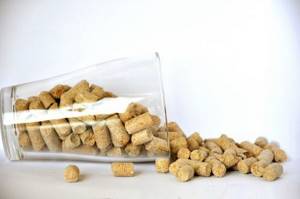
The cardiovascular system
- Dietary fiber absorbs “bad” cholesterol. As a result, atherosclerotic plaques do not form.
- Potassium and magnesium support the heart muscle and strengthen nerve fibers.
- B vitamins are necessary for the formation of hemoglobin. Normal hematopoiesis does not occur with B complex deficiency.
- B1 is converted in the body to cocarboxylase. An element that improves the functionality of the cardiovascular system.
Pregnancy and childhood
The listed beneficial properties of bran are also relevant during pregnancy. Important for the expectant mother:
- fight constipation;
- strengthen the nervous and cardiac system;
- improve skin condition;
- remove toxic elements from the body;
- prevent the formation of extra pounds.
In recent months, my weight has been growing by leaps and bounds. The gynecologist swears. And hunger torments. Solving the problem – 1 tbsp. l. bran plus a glass of kefir or yogurt.
The product is introduced into the children's menu from 10 months. They do not give the hard shells themselves, but a decoction. Porridge and jelly are cooked on it. From 1 year of age, crushed steamed bran is added to soups: for 1 plate - a third of a teaspoon.
Acne bran
Acne on the face and body is often the result of pollution in the body and improper functioning of the intestines. The internal excretory system does not cope well with its tasks, and the skin has to remove decay products. An anti-acne diet involves eliminating sweet and fatty foods, focusing on vegetables and fruits that contain a large amount of fiber.
The main advantages of the cereal product in this case are:
- cheapness;
- ease of use;
- availability;
- high fiber concentration;
- ease of storage.
Bran can be consumed alone or in combination with other products. They do not cause an allergic reaction and are often used without pre-treatment. On sale there are ready-made balls, flakes, and breads made from bran. In these products you need to carefully study the composition. Often the manufacturer is disingenuous when mixing bran with flour, sugar, and preservatives.
Bran for allergies
Thanks to its adsorbing properties, bran helps free the digestive system from allergens. Of course, medications are often used for this purpose. But not every person agrees to use them regularly. With bran everything is much simpler. The product can be taken daily. In addition to eliminating the body’s allergic reactions, stool will normalize, skin condition will improve, and a couple of extra pounds will disappear.
For allergies, it is recommended to drink bran 30 minutes before meals, diluting the product in purified water or kefir. One tablespoon 3 times a day before main meals is enough. In half an hour, the mixture will transit through the digestive system, collecting impurities and allergens.
Medicinal benefits of bran
Constipation.
Recipe 1:
- Grind oat bran to flour.
Take 1 tsp once a day with a glass of warm water.
Recipe 2:
- Steam the bran, pass through a meat grinder, add pitted prunes and raisins.
- Mix thoroughly and form into balls.
Eat in the morning, wash down with water.
Recipe 3:
- Pour 2 tablespoons of hot milk into a glass. wheat bran, leave in a sealed container for 40 minutes, wrapping it well.
In the morning, take 0.5 cups before breakfast.
For the beauty of face and body
Wonderful scrubs are made from bran that can be used even on sensitive facial skin. Possessing regenerative properties, the product has a beneficial effect on the epidermis, regulates the functioning of the sebaceous glands, and removes dead cells and fat. A simple way to make a scrub is to mix bran with argan oil. For oily skin types, grape seed oil is used. A suitable cleanser is used as a base.
If the scrub is intended for the body skin, then shower gel, body milk, sour cream, and cream are suitable as a base. It is allowed to add coffee grounds, granulated sugar, and sea salt. Rough peels are used to exfoliate the skin of the feet, cleanse and then soften the knees and elbows.
Harm of bran and contraindications for use
In addition to the benefits, the use of bran can cause harm to the body. It should be immediately stated that the product should not be used together with other medications. There should be at least an hour between doses. There will be no harm from joint use, but there will be no benefit either. Insoluble fiber will carry the drug out of the body and it will not have time to act.
Contraindications for use:
- gastritis during exacerbation;
- stomach ulcer;
- colitis;
- children under 3 years of age.
Also, the harm of bran sometimes manifests itself in bloating, flatulence, and vitamin imbalance. Most often, such reactions in the body occur when the product is consumed in excess of the norm.
How to lose weight - diet and weight loss
Page 8 of 22
2.5. Bran.
Bran is such a unique thing that it’s hard not to admire it. With the help of bran, you can not only cleanse the intestines, but also lose excess weight without doing anything else, without any sports, diets, or bath procedures.
In general, bran (wheat, rye, soy) is a by-product of flour milling. Bran consists of grain shells and unsorted flour. Every grain grower knows that when grain is ground, one fifth of it turns into bran, which is considered waste.
And only recently have they begun to realize that bran is a valuable nutritious raw material. But, nevertheless, in our country they have not yet fully realized the amazing value of this product, so the bulk of our bran goes abroad: through Ukraine to Turkey, Israel, Libya, Lebanon, etc.
The main value that bran contains is dietary fiber - an insoluble, insoluble hard and coarse carbohydrate.
Dietary fiber contained in bran is a nutrient medium for normal intestinal microflora, therefore bran is used in the complex treatment of intestinal dysbiosis. In addition, intestinal bacteria, consuming fiber, release essential B vitamins.
Swelling under the influence of water, dietary fiber forms a large volume of feces - more loose, which facilitates bowel movements and relieves constipation. Regular consumption of bran can relieve habitual constipation and prevent its occurrence in the future, after stopping bran intake (restoring the normal bowel movement reflex)
It is fiber, and this is up to 30-40% of the volume of bran, that is used in the fight against excess weight: food with a large amount of fiber is absorbed more slowly and gives a feeling of fullness for a longer time; in addition, intestinal motility increases, which reduces the absorption of nutrients and, therefore, the calorie content of the food eaten.
The dietary fiber contained in bran binds cholesterol, so bran can be used to prevent atherosclerosis. A positive effect of bran in diabetes mellitus has been revealed, as it lowers blood sugar levels.
Protein-starch mucus helps eliminate toxins. Bran particles, due to the various fibers they contain, are a universal biological substance that binds heavy metal ions, radionuclides, and harmful breakdown products of nutrients.
The choleretic effect of bran is ensured by their stimulating effect on the general motor ability of the digestive tract (mechanical stimulation). In the form of a dietary supplement, bran is effective for dysfunction of the liver, gallbladder, pancreas, chronic diseases of the stomach and intestines - gastritis, gastroduodenitis, enterocolitis during the period of remission and subsidence of the acute inflammatory process (with an expansion of the diet).
Therefore, taking bran is indicated for dysbiosis, constipation, for the prevention of colon cancer, obesity, diabetes, and is also recommended for consumption by all people interested in proper nutrition.
Modern scientific data say that diseases such as diverticulosis, hemorrhoids, and chronic colitis are associated with a lack of plant fiber in our food.
In addition, bran contains up to 15% protein, as well as potassium, magnesium and other trace elements.
Potassium plays an important role in ensuring the normal functioning of the cardiovascular system and in removing fluid from the body. Magnesium has a vasodilating property, which is why products containing it are included in the diet for hypertension.
In addition to protein, bran is rich in polyunsaturated fatty acids, which are involved in energy fat metabolism, in the formation of cell membranes, and in the immune response.
CONTRAINDICATIONS: bran is not recommended for use in the acute period for gastritis, peptic ulcers, colitis and enteritis of infectious etiology. As the inflammatory process subsides, you can resume taking bran, starting with small doses.
Usually bran is consumed finely ground in the form of flour. 15-20 minutes before each meal, i.e. usually 3 times a day, take 2 tablespoons (10 g) of this ground bran and eat it with water. Bran must be washed down with water (1-2 glasses), otherwise the whole point of using it is nullified.
The daily dose of bran is no more than 30 g. By showing immoderation in the use of seemingly healthy bran, we risk exacerbation of intestinal diseases, bloating, flatulence, intestinal dysfunction, and, at a minimum, hypovitaminosis - nutrients and vitamins will leave our intestines so quickly that little has time to be absorbed by the body.
Once again I draw your attention - bran does not work without water! Those fibrous nutrients for which we eat bran only make sense when they absorb water and swell.
Questions and answers.
Letter:
Is it possible to use molded wheat bran with the addition of apples, sea buckthorn, Jerusalem artichoke, and cranberries?
And are they as effective as ground ones? Answer:
Yes, of course you can. Just don’t forget the simple rule - bran only makes sense when consumed with water. Those. Bran must be washed down with 1 – 2 glasses of water or milk.
« Prev. - Next. »
Where to buy bran
Edible grain shells are sold in grocery supermarkets. You should not look for them in the departments with flour and cereals. Most often they are on shelves with diabetic and dietary products. Sold in bags or in cardboard packs. Bran can also be purchased at pharmacies. If they are not currently in stock, many locations deliver the product to order, which is also convenient.
Tip: If you don’t find bran in your city, you can easily order it online in Dukan diet stores. You can also buy bran flour there. Dietary baked goods are prepared from it: pancakes, pancakes, bread, muffins.
When purchasing bran, first of all pay attention to the expiration date. It should not exceed 12 months. If the product is left behind, it may go rancid. This happens even with a fresh product. You also need to look at the composition. There shouldn't be anything superfluous in it. If bran is mixed with other ingredients, even beneficial for the body, calculating the daily portion becomes more difficult.
After purchasing, the bran is poured into a dry, sealed glass container. The penetration of moisture and light into the product leads to its rapid deterioration.
Bran is an affordable, simple and safe assistant that makes it easy to lose weight, control body weight, maintain health, beautiful and youthful skin. They should be in the diet of a modern person!
source
Bran
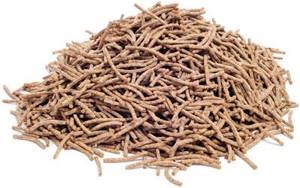
General information
Bran is the hard shell of a grain that contains dietary fiber. They are not digested by enzymes of the gastrointestinal tract, but are remarkably fermented and take part in the nutrition of the microflora of the large intestine. Bran consists of the grain skin (or color shell), the grain germ, and the aleurone layer of the grain - a number of large thick-walled cells that are filled with nutrients (fats, proteins, minerals and vitamins).
The types of bran depend on the type of grain being processed and are: wheat, rice, rye, barley, buckwheat and others. They can also be coarse or fine, large or small - it depends on the degree of grinding.
How to choose
In almost any modern store you can find the “Diet food” section and purchase bran. There are all types of them on sale with different descriptions and prices. There is no difference; even the cheapest ones will correspond to absolutely all the organoleptic properties of a particular type.
Bran is a product that is practically odorless and tasteless. After opening the package, you should smell them and make sure there is no mold smell. You also need to try the bran so that it is without bitterness. You also need to pay attention to the color - normally it is gray-brown.
On the market, bran can also be found in the form of tablets, “corn sticks” and chips, which have different tastes. But it is worth understanding that the form is given by the gluten of the flour and this is not pure bran, but a combination of dietary fiber and flour. Very often, manufacturing companies produce bran with various flavoring additives. You can safely put such packages back on the shelf and pay attention to finding bran without additives or impurities, since they will be much more useful.
How to store
Bran should only be stored in tightly closed jars, into which they should be poured immediately after purchase. Shelf life is long and depends on storage conditions.
Reflection in culture
In the modern world, bran is viewed as waste and is used, at best, for feeding to animals. But even our ancestors knew that white flour, although tastier, does not contain anything other than starch, and because of this it is not useful, and in large quantities it is even harmful. That is why flour was used only on holidays, and every day they baked bread from wholemeal flour, mixing in bran.
Calorie content of bran
Bran, despite the large amount of valuable biological substances, has low nutritional value. So the calorie content of wheat bran is only 165 kcal, rye bran is 221 kcal, and cooked oat bran contains only 40 kcal. All of them are very useful and help perfectly in the fight against excess weight. It is also good to include in your diet, as a replacement for white bread, “Doctor’s Bread”, their calorie content is 242 kcal.
Nutritional value per 100 grams:
There are many varieties of bran and each type has its own nutritional value. The table shows data on several of them.
| Proteins, g | Fats, gr | Carbohydrates, g | Ash, gr | Water, g | Calorie content, kcal | |
| Wheat | 16 | 3,8 | 16,6 | 15 | 5 | 65 |
| Rye | 11,2 | 3,2 | 32 | — | — | 221 |
| Rice | 13,55 | 20,85 | 28,69 | 9,98 | 6,13 | 316 |
| Buckwheat | 38 | 8,6 | 33,8 | — | — | 364,6 |
LiveInternetLiveInternet
Tuesday, December 20, 2011 17:53 + in quote book Few people practice bran treatment... But in vain... Bran is such a unique thing that it is difficult not to admire it. With the help of bran, you can not only cleanse the intestines, but also lose excess weight without doing anything else, without any sports, diets, or bath procedures. In general, bran (wheat, rye, soy) is a by-product of flour milling. Bran consists of grain shells and unsorted flour. Every grain grower knows that when grain is ground, one fifth of it turns into bran, which is considered waste. And only recently have they begun to realize that bran is a valuable nutritional raw material. But, nevertheless, in our country they have not yet fully realized the amazing value of this product, so the bulk of our bran goes abroad: through Ukraine to Turkey, Israel, Libya, Lebanon, etc. The main value that bran contains is dietary fiber - an insoluble, insoluble hard and coarse carbohydrate. Dietary fiber contained in bran is a nutrient medium for normal intestinal microflora, therefore bran is used in the complex treatment of intestinal dysbiosis. In addition, intestinal bacteria, consuming fiber, release essential B vitamins. Swelling under the influence of water, dietary fiber forms a large volume of feces - more loose, which facilitates bowel movements and relieves constipation. Regular consumption of bran can relieve habitual constipation and prevent their occurrence in the future, after stopping the use of bran (restoration of the normal bowel movement reflex). It is fiber, and this is up to 30-40% of the volume of bran, that is used in the fight against excess weight: food with a large amount fiber is absorbed more slowly and gives a feeling of fullness for a longer time; in addition, intestinal motility increases, which reduces the absorption of nutrients and, consequently, the calorie content of the food eaten. The dietary fiber contained in bran binds cholesterol, so bran can be used to prevent atherosclerosis. A positive effect of bran in diabetes mellitus has been revealed, as it lowers blood sugar levels. Protein-starch mucus helps eliminate toxins. Bran particles, due to the various fibers they contain, are a universal biological substance that binds heavy metal ions, radionuclides, and harmful breakdown products of nutrients. The choleretic effect of bran is ensured by their stimulating effect on the general motor ability of the digestive tract (mechanical stimulation). In the form of a dietary supplement, bran is effective for dysfunction of the liver, gallbladder, pancreas, chronic diseases of the stomach and intestines - gastritis, gastroduodenitis, enterocolitis during the period of remission and subsidence of the acute inflammatory process (with an expansion of the diet). Therefore, taking bran is indicated for dysbiosis, constipation, for the prevention of colon cancer, obesity, diabetes, and is also recommended for consumption by all people interested in proper nutrition. Modern scientific data say that diseases such as diverticulosis, hemorrhoids, and chronic colitis are associated with a lack of plant fiber in our food. In addition, bran contains up to 15% protein, as well as potassium, magnesium and other trace elements. Potassium plays an important role in ensuring the normal functioning of the cardiovascular system and in removing fluid from the body. Magnesium has a vasodilating property, which is why products containing it are included in the diet for hypertension. In addition to protein, bran is rich in polyunsaturated fatty acids, which are involved in energy fat metabolism, in the formation of cell membranes, and in the immune response. Contraindications to treatment with bran: bran is not recommended for use in the acute period for gastritis, peptic ulcers, colitis and enteritis of infectious etiology. As the inflammatory process subsides, you can resume taking bran, starting with small doses. Usually bran is consumed finely ground in the form of flour. 15-20 minutes before each meal, i.e. Usually this is 3 times a day, take 2 tablespoons (10 g) of this ground bran and eat it with water. Bran must be washed down with water (1-2 glasses), otherwise the whole point of using it is nullified. The daily dose of bran is no more than 30 g. By showing excess in the use of seemingly healthy bran, we risk exacerbation of intestinal diseases, bloating, flatulence, intestinal dysfunction, and, at a minimum, hypovitaminosis - nutrients and vitamins will leave our intestines so quickly that little has time to be absorbed by the body. Once again I draw your attention - bran does not work without water! Those fibrous nutrients for which we eat bran only make sense when they absorb water and swell.
A series of messages “healthy drinks, foods”:
Part 1 - Fat-burning cocktail Part 2 - Cereals that remove fat from the body... Part 4 - THE SECRET OF FAST WEIGHT LOSS IS REVEALED!!!!!! Part 5 - Speed up your metabolism! Part 6 - Bran treatment Part 7 - Drainage drinks Part 8 - miracle products for weight loss... Part 25 - Summer smoothie recipes for weight loss Part 26 - Sassi water Part 27 - structured medicinal water - in a simple way.
Cited 29 times Liked by: 4 users
Like share
0
Like
- 4
I liked the post - Quoted
- 0
Saved
- Add to quote book
- 0
Save to links
Liked4
0
Useful properties of bran
Composition and presence of nutrients
Bran has a very rich and rich composition. Wheat combines a complex of vitamins PP, B1, B2, B6, E and provitamin A necessary for the body. They are rich in the following minerals: magnesium, potassium, chromium, copper, zinc and others. It is this composition that makes bran an indispensable dietary product. They are also rich in insoluble fiber and are useful for reducing the risk of developing various colon diseases.
Barley and oat bran reduce blood cholesterol levels due to their soluble fiber content. Studies have found that taking 60 grams of this bran daily can reduce blood cholesterol by 7-10%. Rice bran contains niacin, thiamine, iron, phosphorus.
Bran contains a large amount of selenium, which, in combination with vitamin E, takes part in the oxidative processes of the human body. It is also involved in DNA synthesis.
Useful and healing properties
Bran is extremely useful for normalizing the functioning of the digestive organs, especially with atony and dyskinesia of the intestines, gallbladder, constipation and stagnation of bile. Scientists have found that with regular use of bran in food, microbes, toxins, toxic salts of heavy metals (mercury, lead, cadmium), and cholesterol are removed from the intestines.
The high content of potassium, magnesium and vitamins helps normalize blood sugar levels, lower blood pressure and limit obesity. Dietary fiber improves intestinal microflora and prevents the occurrence of dysbacteriosis. Bran improves bile secretion in case of hypomotor dyskinesia. They also help people who suffer from frequent constipation and are overweight. For those wishing to lose weight, bran is of great benefit: with a large amount of fiber, food is absorbed more slowly, the feeling of fullness lasts much longer and intestinal motility increases, which reduces the absorption of nutrients.
So, summing up the beneficial properties of bran, we can conclude that they are indicated for both healthy people and those who are struggling with such diseases: hypertension, atherosclerosis, obesity, intestinal atony, biliary dyskinesia, bile stagnation, chronic constipation, varicose veins.
In cooking
Bran is successfully used in cooking. When baking, it is recommended to add 60-100 grams of bran to 500 grams of flour. Dishes with their addition are one of the most important ways to enrich the daily diet with plant fiber. Bran is also added instead of flour to various cutlet masses of meat, fish, vegetables, cottage cheese dishes, instead of semolina - in casseroles, soups, sauces, jellies, compotes, jelly, and instead of rice - in stuffed vegetables and meatballs. Bran is an excellent addition to fish, dairy, pumpkin soups and salads.
To improve the taste of the bran, it is recommended to fry it in the oven, grind it and sift it before use.
In cosmetology
Bran is widely used in cosmetology in various fields. They are not only useful for the human body, but also excellent helpers in the active fight against excess weight. A large amount of plant fibers that make up bran, when consumed, are slowly digested, swell in the stomach and increase the volume of food eaten - this creates the illusion of satiety. Fiber has a positive effect on eliminating the main cause of obesity – metabolic disorders.
Bran, especially rice and almond bran, is actively used as a component of homemade cosmetics. Very popular are masks made from bran brewed with milk for gentle peeling, lifting and softening of the skin. Facial cleansing can be done using oat, wheat or rice bran. To do this, you need to moisten your facial skin with warm water, pour a small amount of water over the bran and stir until a paste forms. Use your hands to apply it to the skin. After 15 minutes, wash off the mask with water.
A bath with bran gives a pleasant feeling of softness and cleanliness of the skin of the body. For this procedure, you need to wrap 200 grams of bran in a double layer of gauze and hang it on the tap, so that the water flows down the bag. After filling the bath, you can dangle the same bag in it. After taking water procedures, you should not dry your skin with a towel.
You can improve your hair with bran by using a decoction containing a large amount of micronutrients that improve the hair structure and make it silky.
Dangerous properties of bran
Bran is contraindicated in case of exacerbations of diseases of the gastrointestinal tract: colitis, gastritis, enteritis, peptic ulcer of the duodenum, stomach, erosions, diarrhea, adhesions in the abdominal cavity.
Reception can be resumed only when the acute period subsides, and then with caution and in small doses. You can consume bran only after pre-treating it with boiling water, and you must also wash it down with plenty of water.
Do not forget about the permissible amount of bran intake, which must be agreed with the attending physician, since excessive use can lead to exacerbation of diseases and disruption of intestinal function: bloating, flatulence, etc.
One of the episodes of the program “Everything Will Be Good” will introduce you to the secrets of easy weight loss with the help of bran.
source
Benefits of bran
The reason for the high biological value of bran is the germ layer, which contains vitamins and minerals.
The insoluble fiber included in the composition is resistant to the action of digestive juices and enzymes. When exposed to moisture, it swells and increases volume. It passes unchanged through the gastrointestinal tract and does not create a load on the glands.
The benefit of bran is the rapid onset of a feeling of satiety. You manage to eat less of other foods, which is useful for losing weight. Promote the development of beneficial microflora in the large intestine.
Insoluble plant fibers mechanically bind waste, promote the formation of feces, and stimulate intestinal motility.
Plant fiber slows down the absorption of carbohydrates, which prevents an increase in blood sugar, binds cholesterol, and normalizes increased levels of estrogen - one of the causes of female tumors and breasts.
Wheat bran is especially beneficial for the female body.
The predominance of refined foods in the diet, which contain little bran, is a common cause of constipation and irregular bowel movements. Plant fibers reduce the risk of colitis and hemorrhoids.
Insoluble fiber is a complex carbohydrate that does not increase blood glucose levels and reduces the risk of type 2 diabetes.
The varied mineral and vitamin composition is especially useful for those who are obese or overweight.
Excess weight is associated with metabolic syndrome, which includes hypertension, increased blood glucose levels, fat deposits around the waist, and elevated cholesterol levels.
Signs of metabolic syndrome are associated with the composition of the intestinal microflora, which depends on the inclusion of fiber in the diet.
Eating foods low in insoluble fiber changes the composition of the intestinal microflora. Microorganisms damage the epithelial cells of the intestinal walls, and inflammation develops. Therefore, a lack of bran contributes to the development of metabolic syndrome.
Study confirms the benefits of whole grains without removing the bran on weight loss and obesity in middle-aged women.
The study confirms that including enough dietary fiber in the diet reduces the risk of cardiovascular disease and mortality from respiratory diseases.
Research and research have linked eating whole grains and reducing the risk of coronary heart disease (CHD).
The study suggests a link between moderate consumption of plant fiber and a reduced risk of cardiovascular disease.
The benefits of bran are the formation of short-chain fatty acids in the colon, which reduces the risk of cancer, and they have a protective effect.
Bran
This is the hard shell of grain that remains after it has been processed during flour milling. Due to its high fiber content, this product is classified as low-calorie - from 110 kcal per 100 g, depending on the cereals used. It contains various vitamins, minerals, saturated and unsaturated fatty acids and proteins of plant origin, which allows it to sometimes be used as a complete food product. For example, instead of breakfast in the morning, like porridge, steam it with boiling water or eat it with kefir.
The main beneficial properties of bran are associated specifically with the effects of fiber:
- They remove harmful substances and waste from the body.
- Helps restore healthy intestinal microflora.
- Reduce the likelihood of diabetes or the manifestation of its symptoms.
- They reduce cholesterol levels in the blood, which helps normalize the functioning of the cardiovascular system.
- They have a positive effect on the condition of the urinary and lymphatic systems.
- Activate digestive processes in the intestines.
- They promote weight loss, both through their effect on the gastrointestinal tract and due to their ability to swell and reduce hunger.
B vitamins contained in bran affect the process of hematopoiesis and the functioning of the nervous system.
The presence of vitamins A and E in this product provides:
- Improving the functioning of the immune system, and protecting against colds, group, various infections of the respiratory system, digestion and urinary system.
- Restoring healthy skin and hair.
- Preservation of visual acuity.
- Normalization of progesterone production and improvement of hormonal balance.
- Positive effect on blood circulation.
- Improved regeneration.
Contraindications
Bran has limitations in its use. They are prohibited for use in the presence of acute inflammatory or infectious diseases of the gastrointestinal tract, such as:
- Gastritis and stomach ulcers during exacerbation.
- Pancreatitis.
- Inflammation of the duodenum.
- Colitis.
- Intestinal diseases.
And also if there are adhesions in the abdominal cavity.
This product should not be used if you are hypersensitive to it. During pregnancy, it is important to follow the dosage, since activation of the intestines can affect the tone of the uterus. You should not take bran in parallel with medications, as they can absorb and remove the drug before it enters the bloodstream and begins to act.
And even in the case of a healthy body, it is necessary to follow the rules of administration and dosage of this type of fiber:
- Don't start with a large amount at once. In the first days, 1 tbsp will be enough. spoons, then gradually increase the dose to 3 tbsp. spoons.
- Do not forget to drink enough clean water - more than 2 liters per day. Dilute the product with water or kefir. Or drink it after taking it if you eat it in granules.
- Remember that you need to take breaks from taking it.
Types of bran
According to the form of release they are:
- Rough. They have a good effect on the lower part of the intestine, blood supply to the pelvic organs, and help reduce the overall sludge load in the body. Available in granule form.
- Thin. Regulates the functioning of the stomach, duodenum, and pancreas. Improves food digestibility and normalizes metabolism. Used for making porridge and baking.
Depending on what grain it is produced from, bran comes in the following types:
- Oatmeal.
- Rye.
- Amaranthaceae.
- Rice.
- Linen.
- Corn, etc.
They are also distinguished by the components used, which enhance and complement the effects of the main ingredient:
- Without anything.
- With milk thistle.
- With Jerusalem artichoke.
- With kelp and other additives.
Each of the above types has its own characteristics and properties. For example, barley has a better effect on the cardiovascular system, as it includes more fine fiber, which binds fatty acids in the intestines and reduces cholesterol levels. Wheat, due to its structure, helps with constipation, etc. But they all contain coarse fiber, amino acids, minerals and vitamins, and will undoubtedly be beneficial to your body.
source
Wheat bran for weight loss
A special property of the cell is its ability to slow down the process of carbohydrate absorption, which is why the level of glucose in the blood increases slowly. For people suffering from diabetes, this makes it possible to significantly reduce the intake of insulin and improve their well-being, and in the absence of this disease, slowing down the absorption of carbohydrates allows them to maintain a feeling of fullness longer. Also, increasing in volume when mixed with liquid, fiber creates a feeling of fullness and prevents a person from overeating, eating extra calories, which will then turn into excess weight. In other words, bran significantly reduces the frequency of meals, creates a feeling of satiety with food and does not allow the feeling of hunger to arise, protecting the stomach from the troubles that arise from simple fasting.
About the benefits and harms of bran
The craze for fashionable diets and food with the prefix “eco” has forced adherents of a healthy diet to remember such a healthy product as bran. The benefits and harms, composition and nutritional value, indications for use are of interest to everyone who wants to improve their health by eating whole grain products.
The myth that bran is the food of common people has long been forgotten. Many famous people talk about regularly consuming bran. What is this miracle product that has been talked about so often lately? Let's find out!
What is bran
Bran is a waste of flour milling production, consisting of seed germs and grain shells. After processing the seeds, a light brown bulk product remains.
It contains valuable substances :
- cellulose;
- vitamins;
- proteins;
- carbohydrates;
- unsaturated fatty acids;
- micro and macroelements.
Looking at this list, it is difficult to call bran the word “waste”. Rather, it is a by-product of flour production.
You can read about the bodyflex system itself here.
The value of dietary fiber
Fiber , contained in whole grain products, is necessary for humans for the normal functioning of all body systems. In bran its content reaches 80% .
The record figure puts bran in first place in terms of dietary fiber content among plant products. Animal products do not contain fiber.
The benefits of bran are difficult to overestimate. In winter you can’t do without them at all.
The benefits of fiber:
- lowers the level of bad cholesterol;
- prevents dangerous glucose surges;
- cleanses the body of toxins;
- helps maintain normal weight;
- maintains the health of the intestinal tract, improves the composition of the intestinal microflora.
Useful properties of bran
Intestinal function is restored .
The inclusion of whole grain products helps overcome constipation and improve the composition of microflora. The proper functioning of the intestinal tract immediately affects the condition of hair, nails and skin. The person looks much fresher. The functioning of the liver and gall bladder improves . Once in the stomach, they promote the production of heat and a sufficient amount of mucus, which improves the functioning of the digestive system.
Toxins are removed from the body . Bran, like a vacuum cleaner, collects everything harmful that is deposited on the walls of the intestines and blood vessels: toxins, radionuclides, excess cholesterol.
Blood sugar levels decrease . Substances contained in bran prevent excess glucose from entering the circulatory system. For diabetics, whole grains are a real lifesaver for controlling sugar levels.
Cholesterol levels decrease . Dietary fiber effectively limits the circular circulation of bile acids. Cholesterol bound by fiber is excreted from the body. The body reabsorbs the fat-like substance in smaller quantities than without consuming bran.
It's easier to control your weight . After consumption, dietary fiber swells in the stomach, the volume increases many times. A feeling of fullness is achieved faster. Just a couple of steamed teaspoons of bran before or during meals - and you are unlikely to eat an extra bun or another sandwich.
Supports women's and men's health . Hormonal imbalance due to lack of progesterone and potency disorders are common problems. Ordinary bran will help normalize the condition as one of the elements of therapy. Vitamins A and E, Omega-3 fatty polyunsaturated acids are a natural source that maintains normal hormone levels.
Vitamins and minerals, a large number of micro and macroelements, fiber, proteins, carbohydrates, various types of fatty acids in bran allow a comprehensive effect on various body systems . Eating whole grain products is a cheap and effective way to improve your health and prevent the development of disorders and malfunctions in the body.
Benefits of wheat bran
When producing flour from wheat, many other things also fall into the bran category:
- aleurone layers of grain shells;
- flower shells;
- wheat germ.
Surprisingly, it is these components of the grain that concentrate almost 90% of all useful components of wheat grain, namely proteins, fiber, minerals and vitamins. But when grinding wheat into flour, the bran is specially separated from the grains in order to preserve the physical and taste qualities of the future flour for a longer period.
Bran is rich in B vitamins, without which the body’s metabolic processes are impossible and the deficiency of which leads to disturbances in carbohydrate, protein, water-salt and fat metabolism. A number of vitamins in this group are responsible for the activity of the hematopoietic organs, the synthesis of the blood protein hemoglobin and the functioning of red blood cells. Also, B vitamins support the functioning of the nervous, muscular, digestive and cardiovascular systems of the human body, help the endocrine system maintain hormonal balance, and promote the production of hormones by the endocrine and reproductive systems.
Vitamins A and E contained in bran, along with B vitamins, work for the benefit of tissues, helping their regeneration, improve and heal skin, hair and nails, allow you to maintain excellent vision and support the immune system.
The role of bran in the digestive system
Fiber, which is abundant in wheat bran, retains a large amount of liquid, diluting the stool in the intestines and helping it move food products through the colon. By absorbing moisture, fiber also absorbs toxins that accumulate in the intestines. Due to this feature of the porous structure of bran, they are used in the treatment of constipation, intoxication and disorders of the digestive tract, and in the prevention of intestinal cancer.
Fiber is an excellent nutrient medium for beneficial intestinal bacteria: when taken, the intestinal microflora is normalized, which is why dysbiosis and the accompanying unpleasant effects of intestinal function disappear. Vitamins from fiber help microtraumas of the mucous membrane to heal faster, stimulate the production of gastric juice, liver activity and pancreas activity. For this reason, bran is taken for biliary dyskinesia, gallstones and a number of other diseases of the liver and gall bladder.
The role of bran in the activity of the heart and blood vessels
Fiber and B vitamins lower the amount of cholesterol in the blood, preventing its accumulation in the blood vessels of the body. Cocarboxylase, a product of vitamin B1 processing, together with potassium and magnesium, have an overall positive effect on the heart and blood vessels, promote trophism of the nervous system, and help body cells absorb glucose. Thus, taking bran becomes an excellent prevention of many diseases of the cardiovascular system.
The role of bran in the functioning of the reproductive system
Wheat bran is rich not only in vitamins, but also in healthy fatty acids, which normalize the level of estrogen in a woman’s body. This reduces the risk of a number of specifically female diseases. For men, bran is useful for its ability to maintain and increase potency.
Contraindications
Is bran good for everyone? There are no serious contraindications to the use of whole grain products .
You should not use bran if :
- acute form of gastritis;
- stomach ulcer;
- gastroduodenitis;
- pancreatitis;
- colitis;
- adhesions in the abdominal cavity;
- allergies to a protein found in grains called gliadin.
Fiber increases intestinal motility. For this reason, bran is not recommended for certain diseases of the intestinal tract .
Pregnant women should not consume more bran than normal . Increased bowel function can increase the tone of the uterus.
Bran is given to children in the form of a vitamin decoction . 1 tsp bran is poured with boiling water and cooked for about 15 minutes. Strain. Porridge or soup is prepared using this broth.
In everything you need to know when to stop. These golden words also apply to the use of whole grain products to normalize the body’s condition in case of various diseases and for their prevention.
Types of bran
Bran is obtained from various grains.
All of them are good for health. The following types of bran can be found on sale:
Wheat bran
A whole grain product is obtained by processing wheat. More than 90% of the nutrients remain in the grain shell. The biological value of wheat bran has been proven for a long time. This type is the most popular in our country.
- fiber cleanses the intestinal walls, taking with it toxins and carcinogens;
- dietary fiber swells and fills the stomach. A person does not overeat;
- B vitamins are involved in all types of energy metabolism, regulate the activity of the muscular, digestive, and nervous systems;
- vitamins A and E are necessary for brain activity, women's and men's health, excellent vision and regulation of hormonal balance;
- phosphorus, zinc, sulfur, zinc, iodine increase immunity, improve the condition of hair and nails, and accelerate tissue regeneration. the level of “bad” cholesterol decreases.
No harmful effects on the body were noted.
- causes bloating;
- protein and mineral balance is disturbed.
Contraindications:
Oat bran
The fashion for using them came to us from the USA. It was the Americans who were the first to appreciate this useful product, for whom the cult of health became a national trait. Scientists were amazed by the composition of oat bran and the benefits they bring to the body.
- cellulose;
- proteins and carbohydrates;
- polyunsaturated amino acids;
- various sugars;
- vitamins of group PP BH, vitamin A, E, D, C, K;
- lutein and lycopene;
- more than 10 micro and macroelements.
- prevent colon cancer;
- used in therapeutic nutrition for disorders of the digestive organs, liver, and gall bladder;
- remove carcinogens and toxins;
- lower the glycemic index (this is important for diabetics);
- bind unnecessary cholesterol, increasing the effectiveness of treatment of atherosclerosis.
The oat product does not cause any harm . Consume 1-3 teaspoons per day and your health will improve.
Rye bran
Residues after processing rye grains contain many useful substances . Present:
- potassium, magnesium, phosphorus, copper, zinc and other elements;
- vitamins A, K, E, B vitamins;
- cellulose;
- fats, proteins and carbohydrates.
Rye bran is quite high in calories . Suitable for feeding athletes and weakened people.
- rye bran bread copes well with constipation;
- A decoction with this miracle product helps reduce blood pressure;
- the intestines are cleansed of toxins;
- metabolism is normalized;
- the condition of nails and hair improves.
Eat whole grains at lunch. The right time will allow all valuable substances to be absorbed as completely as possible. Amount – up to 150 g per day.
No negative effects were noticed . For ulcers and gastritis, bran is not recommended.
Flax bran
They contain a wide range of multivitamins and substances valuable for humans .
This product is indispensable for a healthy life and weight loss. Fiber makes up up to a quarter of the volume of flax seed . There are antioxidants, vitamins, minerals, micro and macroelements. Omega-3 fatty acids are contained here in quantities that are 100 times higher than the content of this valuable substance in wheat bran.
- fight fungal diseases;
- have antitumor properties;
- perfectly cleanse the body;
- promote weight loss;
- help get rid of constipation;
- maintain hormonal balance in women;
- break down excess fat.
Flax bran does not harm the body . If you follow the norm - no more than 2-4 tablespoons during the day, they have a positive effect.
Types of bran: a detailed overview
Bran is classified according to the type of raw material. Can the bran be based on wheat, rye, flax? hemp, buckwheat. Each type of bran is beneficial for proper nutrition; often their properties are similar, but they also have their own characteristics. Subspecies differ in the ratio of nutrients, taste, cost and availability, and indications.
Wheat bran
General characteristics: A by-product of the flour milling industry, namely the outer shell of wheat grains. Available in granular and loose form. The second option is considered the most useful.
KBJU: Proteins – 14.7 g, fats – 4.1 g, carbohydrates – 20.6 g. Calorie content per 100 g – 180 kcal.
Taste: Sweetish, herbaceous and nutty. In appearance - small, light, light beige husk. The particles themselves are soft, the smell is barely pronounced.
Benefits: Improvement of the body's metabolic processes, cleansing of toxic or clogging substances, normalization of intestinal microflora. The functions of the central nervous system, gastrointestinal tract, muscles, heart and blood vessels are supported. The benefits of bran include magnesium and calcium, zinc, sulfur, iodine, copper, vitamins A, E and group B.
Disadvantages or harm: You cannot exceed the norm, then useful substances will leave with toxins. Do not use for ulcers or colitis. It is better to reduce portions in acute forms of gastritis, cholecystitis, pancreatitis and hepatitis.
For whom bran is useful: It is recommended to consume it while losing weight, as it does not provoke weight gain, but, on the contrary, stimulates weight loss and protects against overeating. The product is indicated for diabetes, gout, colds or constipation.
Where you can add it: In porridge, salad, dough, minced meat. The bran subtype goes well with kefir, compote, and jelly. Popular dishes: pancakes, cookies and muffins, pies, bread, pancakes or salads.
Cost per 100 g: On average from 15 to 30 rubles. It’s easy to find in stores, especially in supermarkets and large chains.
Verdict: Wheat bran is the most popular type. You can cook any dish thanks to its delicate texture. Recommended for weight loss.
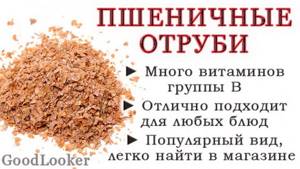
Oat bran
General characteristics: Residues after grain processing, outer shell of oats. Particles come in different sizes, two degrees of grinding: coarse and fine. The dominant element in the composition is fiber.
KBJU: Proteins – 17.3 g, fats – 7 g, carbohydrates – 50.8 g. Calorie content per 100 g – 246 kcal.
Taste: Neutral, almost tasteless. The plates are thin, of various sizes, beige or light brown. Bready aroma.
Benefits: Increased peristalsis in the gastrointestinal tract, stabilization of microflora, cleansing of toxins and waste. The absorption of carbohydrates slows down, the percentage of cholesterol and blood pressure are normalized. Contains vitamins B and K, magnesium, phosphorus, iron.
Cons or harm: Digestive problems when overeating. Exacerbation of gastrointestinal diseases, intestinal inflammation, and intolerance interfere with consumption.
For whom bran is useful: Indicated for cholecystitis, diabetes, constipation, chronic pancreatitis or gastritis. Bran is needed when losing weight, as it reduces the production of hunger hormones and increases satiety hormones.
Where you can add it: In cottage cheese, yogurt, salads, pancake and baking dough, as well as in hot vegetable dishes. Oat bran is often consumed with juice or compote, kefir, milk, or simply washed down with water.
Cost per 100 g: On average 25-40 rubles. You can take it from the Internet, but you can also find it in regular stores and supermarkets.
Verdict: Oat bran is an excellent addition to many dishes. There is no bitterness, but the aroma is pleasant. This subspecies is recommended on most diets.
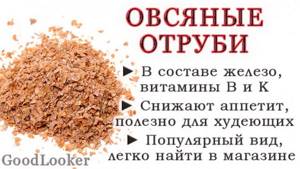
Rye bran
General characteristics: Product of processing of rye grains. Initially, this species was used as livestock feed or fertilizer, but it was discovered that the shells contained many useful substances. Therefore, they began to use it as a food additive.
KBJU: Proteins – 11.2 g, fats – 3.2 g, carbohydrates – 32 g. Calorie content per 100 g – 221 kcal.
Taste: Dried grains or overcooked bread crumbs. The particles have a brown color and a friable texture.
Benefits: Normalization of sugar and cholesterol, removal of toxins and improvement of intestinal motility and microflora. The work of the gastrointestinal tract, blood vessels and heart, thyroid gland, immunity, and central nervous system is supported. Metabolism accelerates. Lots of zinc, iron, iodine, magnesium and vitamins B, K, A and E. Contains Omega-3, Omega-6.
Cons or harm: If the dosage is exceeded, nausea, bloating, diarrhea. This type of bran is prohibited for gastrointestinal infections, ulcers, gastritis, intolerance.
For whom bran is useful: Reception is recommended for athletes and those who are losing weight or on PP. Bran helps with colds, hypovitaminosis and diabetes, gout, constipation, cholecystitis.
Where you can add it: To salads, first and second courses, minced meat, porridge and baking dough, jelly desserts, jelly. Used for breading.
Cost per 100 g: On average 15-30 rubles. Sold in most stores, as well as in pharmacies and the Internet.
Verdict: Rye bran is a subspecies with a specific taste, so it is not suitable for everyone. The product is considered more useful than those made from wheat grains, since the proteins contain more amino acids. Rye contains a lot of iodine and vitamin E.
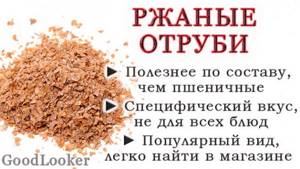
Corn bran
General characteristics: Husk from corn grains. The hard shell is first removed and crushed, and the kernels are used for flour. It is this material that contains up to 80% of useful substances.
KBJU: Proteins – 8.4 g, fats – 1 g, carbohydrates with fiber – 85.6 g. Calorie content per 100 g – 225 kcal.
Taste: Pleasant. The yellowish particles are small, moderately hard, not rough.
Benefits: Reducing bad cholesterol levels, improving metabolism and stabilizing blood pressure. The immune system, heart and blood vessels are strengthened, and the body is cleansed of toxins. Gastrointestinal functions are supported. It contains a lot of copper, selenium, iron and potassium, vitamins K, B, A and E, starch, and proteins.
Disadvantages or harm: Due to excess volume, gases appear with fermentation processes in the gastrointestinal tract. If you don't drink enough water, dehydration can occur. Not suitable for intestinal and stomach diseases.
Who benefits from bran: Recommended for people with anemia, gluten intolerance and constipation. You can take it while losing weight, but not regularly.
Where you can add it: In bread, porridge, soups and salads, dough for pies, pancakes or flatbreads. Wash it down with yogurt, kefir and juice. An example of a dish is boiled grated beets, combined with bran and seasoned with vegetable oil.
Cost per 100 g: On average 30-40 rubles. This variety is extremely rare in offline stores.
Verdict: Corn bran is one of the best representatives of the segment, it has a pleasant taste, delicate texture and a lot of fiber. The body is nourished by energy, and saturation remains for a long time. The benefits of bran in helping with weight loss.
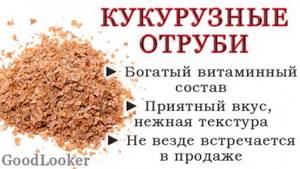
Amaranth bran
General characteristics: Production from amaranth seed shells. Hard and tough husks are crushed and produced in bulk form or in granules.
KBJU: Proteins – 20.4 g, fats – 5.1 g, carbohydrates – 67 g. Calorie content per 100 g – 311 kcal.
Taste: Specific, herbaceous, with a hint of damp earth taste.
Benefits: Normalization of gastrointestinal acidity, healing of stomach walls, cleansing of toxins, bad cholesterol. Metabolism accelerates, hormonal levels stabilize. Lots of protein, essential amino acids, minerals.
Cons or harm: If you are taking medications, it is better to postpone the bran for 2-3 hours. Not for any problems with the gastrointestinal tract, especially during exacerbations.
Who benefits from bran: People with gluten intolerance, enuresis or men with genitourinary problems. It is recommended to consume during diets and for weight maintenance, as the product saturates for a long time.
Where you can add it: To salad, kefir, juice, smoothie, porridge. A popular breakfast dish is to mix pumpkin, raisins and bran in a blender and add milk.
Cost per 100 g: On average 40-60 rubles. It is not often sold in stores, unless in the nutrition departments. Can be ordered online.
Verdict: The amaranth product is among the best PP bran, since the composition is not oversaturated with fiber. Therefore, there is no risk of overdose or problems with the gastrointestinal tract.
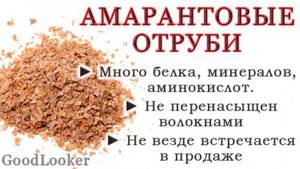
Rice bran
General characteristics: Obtaining the top layer of rice grains from the shell; kernel particles are also included. Usually the brown variety is used for bran.
KBJU: Proteins – 13.4 g, fats – 21 g, carbohydrates – 28.9 g. Calorie content per 100 g – 316 kcal.
Taste: Slightly sweetish nutty flavor, texture reminiscent of flour.
Benefits: Gently cleansing the body of toxins, normalizing the microbiota in the gastrointestinal tract, stabilizing sugar and cholesterol levels, supporting the functions of the liver and pancreas. Contains vitamins B, PP, E, A and K, magnesium, potassium, Omega-3.
Disadvantages or harm: Prohibition of use during exacerbation of gastritis, peptic ulcers, diarrhea, high acidity in the stomach and other gastrointestinal problems.
Who benefits from bran: Recommended for diabetics, people with bile stagnation or constipation. The product helps with bronchitis, pneumonia and gout. Bran is also used for weight loss due to its long-lasting feeling of fullness.
Where you can add it: In porridges, soups, salads, breads, PP muffins and cookies. Bran is used in dough for pancakes and pancakes. The best option would be a drink or decoction.
Cost per 100 g: From 20 to 40 rubles. Bran is found infrequently, as it is not yet very popular in Russia. Can be purchased through the online store.
Verdict: Rice supplement is a great aid for weight loss. The metabolism of fats and carbohydrates is normalized, the body is saturated with fiber and energy.
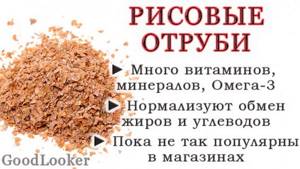
Buckwheat bran
General characteristics: Buckwheat is used as a source. The kernels contain a lot of protein with amino acids and few digestible carbohydrates.
KBJU: Proteins – 16 g, fats – 4 g, carbohydrates – 64 g. Calorie content per 100 g – 343 kcal.
Taste: Bright characteristic aroma, nutty taste, like cereal.
Benefits: Relieving inflammation, strengthening the immune system, stabilizing stool and intestinal microflora, cleaning from harmful substances. Glucose and cholesterol are normalized. Contains vitamins E, PP, A and B, iron, zinc, calcium. There is little gluten and gluten, which has a positive effect on the intestinal walls.
Disadvantages or harm: Cannot be consumed in case of acute pancreatitis, gastritis, ulcers and renal failure. If there is a tendency to gas formation or constipation, then it is better to limit intake.
For whom bran is useful: Diabetics, people losing weight, people with anemia and rheumatism. Appointment is needed for problems with skin, hair, nails.
Where to add: In baking dough, bread, minced meat, cereal, yogurt, milk and juice. A healthy drink is a glass of kefir, buckwheat bran with chia seeds.
Cost per 100 g: On average 25-50 rubles. This is not a frequent guest on store shelves; it’s easier to order online.
Verdict: Crushed buckwheat husk is a useful bran in a healthy diet, as it regulates sugar and cleanses the intestines. Appetite decreases and the feeling of fullness increases. Improves the absorption of microelements.
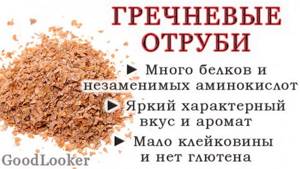
Flax bran
General characteristics: Residues after squeezing oil from flaxseeds. Crushed cake of different degrees of grinding is produced for sale.
KBJU: Proteins – 16 g, fats – 4.3 g, carbohydrates with fiber – 64.5 g. Calorie content per 100 g – 165 kcal.
Taste: Pleasant, slightly oily taste, without bitterness.
Benefits: Strengthens blood vessels, reduces bad cholesterol levels. The metabolic process accelerates, appetite decreases, and the intestines are cleansed. The cake contains a lot of Omega-3, vitamins B and E, zinc, calcium, magnesium, and fiber.
Disadvantages or harm: Laxative effect and the presence of phytoestrogens, which is sometimes harmful for men. Do not use if you have problems with the gastrointestinal tract, allergies or intolerances. If you are taking medication, take it at different times.
For whom bran is useful: People with diabetes mellitus and gallstones, heart and vascular diseases. Invaluable benefits for obesity.
Where you can add it: In juices, yogurt, kefir, vegetable and meat dishes, baking dough, salads. An example of a drink is hot water, bran, honey.
Cost per 100 g: About 70 rubles. This type of bran is found quite often, but mostly in large supermarkets.
Verdict: Flax bran is the best option when there are no contraindications. It is especially recommended when losing weight, as it is low in calories and high in Omega-3.
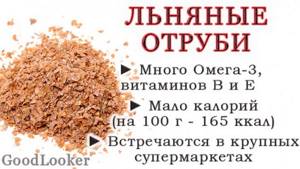
Hemp bran
General characteristics: Obtained from the shell of hemp seeds. The particles eventually take on color, taste and aroma characteristics.
KBJU: Proteins – 16.3 g, fats – 12 g, carbohydrates – 17.8 g. Calorie content per 100 g – 307 kcal.
Taste: Specific, nutty-herbaceous taste.
Benefits: Improves digestion, detoxification and maintains normal sugar and cholesterol levels. The microflora is restored, hormones are normalized. Ingredients: chlorophyll, magnesium, copper, iron and manganese, proteins, fiber.
Cons or harm: Overeating causes bloating and gastrointestinal disorders. It should not be taken for a long time, as the absorption of microelements is impaired.
For whom bran is useful: Vegetarians and raw foodists, people with celiac disease (gluten intolerance) or overweight, high physical and mental stress.
Where you can add it: In porridges, salads, side dishes, soups, sauces, baked goods. Kefir or yogurt can be used as a base for the drink; juice or compote will also work.
Cost per 100 g: About 60-90 rubles. They are very rarely found in stores and even supermarkets; it’s easier to order online.
Verdict: Hemp cake has a low glycemic index, a high proportion of fiber, and a long-lasting feeling of satiety. The benefits of bran for fighting extra pounds or keeping fit are obvious.
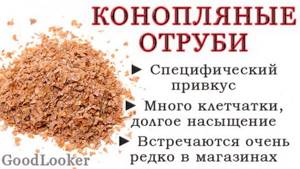
Plantain bran (psyllium)
General characteristics: From the husks of flea plantain seeds. Herbs grow in Pakistan and India. Other names for bran: isfagula, ispaghol.
KBJU: Proteins – 2.9 g, fats – 0.1 g, carbohydrates – 7.3 g. Calorie content per 100 g – 42 kcal.
Taste: Neutral. The particles are grayish-yellow or milky in color.
Benefit: Improves the functioning of the digestive tract and has a beneficial effect on reproductive functions. The feeling of hunger is blocked, the activity of beneficial flora of the gastrointestinal tract increases. Contains up to 70% fiber and fatty oils, zinc, iron, magnesium and calcium. Lots of glycosides, few calories.
Disadvantages or harm: Use is prohibited for ischemia, mental disorders and allergies to plant components, convulsive syndromes, and gastrointestinal diseases.
For whom bran is useful: People losing weight, diabetics, treating diarrhea.
Where you can add it: In dough for low-carbohydrate and low-calorie baked goods or in minced meats and sauces. Psyllium is also used for breading.
Cost per 100 g: About 150-250 rubles. The demand for psyllium is growing, so the product is starting to appear in stores. But for now it’s easier to take it on the Internet.
Verdict: Psyllium bran is a supplement that is gaining popularity. It has no fat, few carbohydrates and calories, but a lot of fiber and nutrients.
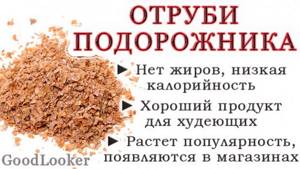
Bran with kelp
General characteristics: Amaranth or oat bran is usually used for the base. Laminaria is an extremely healthy seaweed (cabbage).
KBJU: Proteins – 12-20 g, fats – 5-6 g, carbohydrates – 37-55 g. Calorie content per 100 g – 320 kcal.
Taste: Laminaria gives a peculiar bitter-salty note.
Benefits: In addition to cleansing the intestines, normalizing digestion and regulating sugar and cholesterol, the addition of kelp improves thyroid function and strengthens the immune system. The product has a positive effect on the central nervous system and hematopoiesis.
Disadvantages or harm: To the standard prohibitions in the form of gastrointestinal diseases are added urticaria, tuberculosis, diathesis, diseases of the endocrine and renal systems.
For whom bran is useful: People with heart disease, blood vessels, diabetes, arthritis and hypertension. Bran is excellent for weight loss.
Where you can add it: In soups, porridges, fermented milk products, PP desserts and bread dough. Bran can be added to minced meat, vegetable dish, jelly.
Cost per 100 g: On average 45-50 rubles. They are found in supermarkets or large stores quite often.
Verdict: Bran with kelp is a balanced product that helps replenish microelements, improve iodine balance and lose weight.
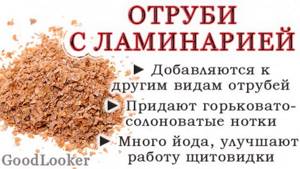
Bran with Jerusalem artichoke
General characteristics: Amaranth or wheat bran is usually used as a base. Jerusalem artichoke (earthen pear) is a healthy root vegetable.
KBJU: Proteins - 13.5-19.0 g, fats - 3.0-5.5 g, carbohydrates - 36.2-55.0 g. Calorie content per 100 g - from 226 to 345 kcal, depending on the base.
Taste: Jerusalem artichoke introduces sweetish, slightly vanilla notes.
Benefits: In addition to the complete normalization of digestion, Jerusalem artichoke stabilizes blood sugar, strengthens the immune system and increases hemoglobin levels. The composition is supplemented with inulin, vitamin C, and silicon.
Disadvantages or harm: Contraindications for use include allergies and intolerance to the components of Jerusalem artichoke.
For whom bran is useful: Diabetics, overweight people. It is recommended to include this supplement in the diet for joint diseases and remission of pancreatitis.
Where you can add it: In fermented milk drinks, jelly, juices, porridges. Can also be consumed as a separate dish or snack.
Cost per 100 g: About 15-40 rubles. Often found in stores.
Verdict: The benefits of bran with Jerusalem artichoke include a positive effect on the gastrointestinal tract and metabolism, and therefore this type of bran is recommended for weight loss. The rich composition of bran with Jerusalem artichoke helps with mineral imbalances and hypovitaminosis.
